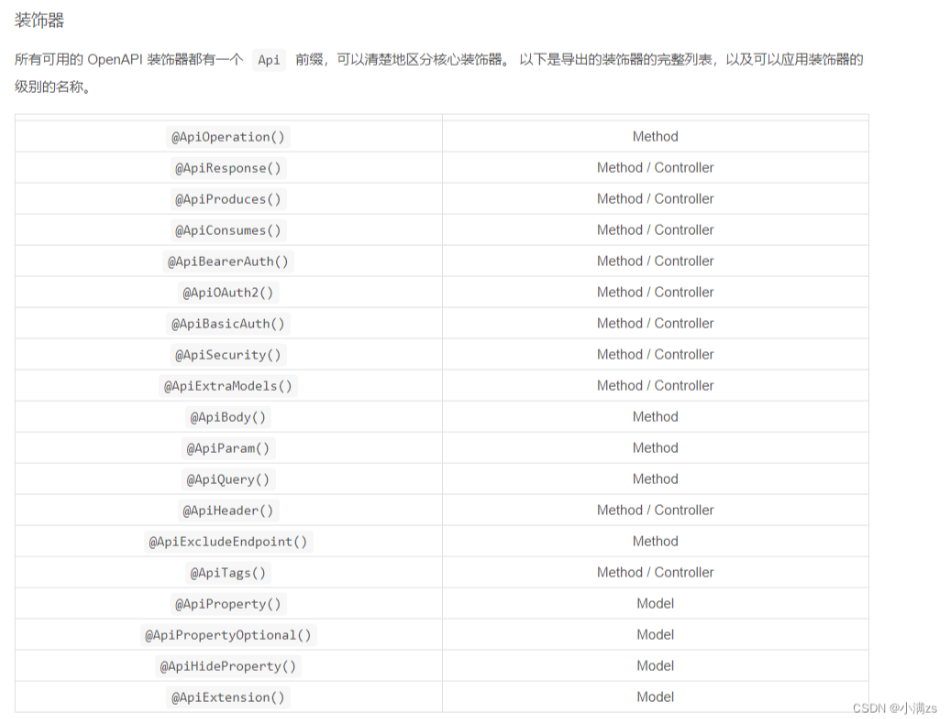NestJs 中使用 Swagger
安装 Swagger
bash
npm install @nestjs/swagger swagger-ui-express创建 Swagger 配置文件
typescript
import { DocumentBuilder, SwaggerModule } from "@nestjs/swagger";
async function bootstrap() {
const app = await NestFactory.create<NestExpressApplication>(AppModule);
const options = new DocumentBuilder()
.setTitle("lz测试项目")
.setDescription("lz测试项目接口文档")
.setVersion("1")
.build();
const document = SwaggerModule.createDocument(app, options);
SwaggerModule.setup("/api-docs", app, document);
await app.listen(3000);
}
bootstrap();访问地址:http://localhost:3000/api-docs
常用装饰器
在 NestJS 中,Swagger 装饰器用于自动生成 API 文档。这些装饰器主要来源于 @nestjs/swagger 包,帮助开发者描述控制器、方法、参数和模型等。以下是一些常用的 Swagger 装饰器及其用途:
@ApiModule- 用途:为模块添加描述。
- 案例:typescript
@ApiModule({ name: "User Module", description: "用户管理模块", }) @Module({}) export class UserModule {}
@ApiController- 用途:为控制器添加描述。
- 案例:typescript
@ApiController("users", "用户相关接口") @Controller("users") export class UsersController {}
@ApiOperation- 用途:描述具体的操作(方法)。
- 案例:typescript
@ApiOperation({ summary: '获取所有用户', description: '返回系统中的所有用户信息' }) @Get() findAll(): string[] { return ['User1', 'User2']; }
@ApiQuery- 用途:描述 GET 请求中的查询参数。
- 案例:typescript
@ApiQuery({ name: 'name', required: false, description: '用户的姓名' }) @Get() find(@Query('name') name?: string): string[] { return name ? [`User: ${name}`] : ['User1', 'User2']; }
@ApiParam- 用途:描述路径参数。
- 案例:typescript
@ApiParam({ name: 'id', type: 'string', description: '用户唯一标识' }) @Get(':id') findOne(@Param('id') id: string): string { return `User ID: ${id}`; }
@ApiProperty用途:描述 Post 请求 body 参数
案例:
typescriptexport class CreateGuardDto { @ApiProperty({ description: "姓名", example: "lz" }) name: string; @ApiProperty({ description: "年龄", example: 18 }) age: number; }
@ApiResponse- 用途:描述接口响应。
- 案例:typescript
@ApiResponse({ status: 200, description: '成功返回用户列表', type: [String] }) @ApiResponse({ status: 404, description: '未找到用户' }) @Get() findAll(): string[] { return ['User1', 'User2']; }
@ApiModel和@ApiModelProperty用途:描述数据模型及其属性。
案例:
typescript@ApiModel({ description: "用户数据传输对象" }) export class CreateUserDto { @ApiModelProperty({ example: "john_doe", description: "用户名" }) username: string; @ApiModelProperty({ example: "123456", description: "密码" }) password: string; }
@ApiBearerAuth- 用途:启用 Bearer 认证。
- 案例:typescript
@ApiBearerAuth() @Get('secure') secureEndpoint(): string { return 'This is a secure endpoint'; }
其他装饰器

参考文章:https://xiaoman.blog.csdn.net/article/details/127181578
